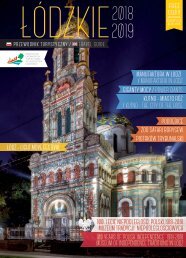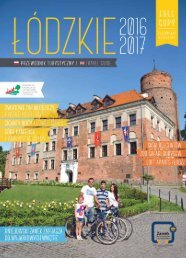ŁÓDZKIE2015
Create successful ePaper yourself
Turn your PDF publications into a flip-book with our unique Google optimized e-Paper software.
THE ARCH CATHEDRAL CHURCH IN TUM<br />
ARCHIKOLEGIATA W TUMIE<br />
KWIATKÓWEK<br />
W Kwiatkówku, nieopodal Łęczycy<br />
i Tumu turysta znajdzie Łęczycką Zagrodę<br />
Chłopską, skansen składający<br />
się z glinianej chałupy, zabudowań gospodarskich,<br />
wiatraka, kuźni i olejarni,<br />
a także studni, kapliczki i uli.<br />
In a small village Kwiatkowek, close<br />
to Tum one can find a Leczyca Peasants<br />
Farm, an open-air ethnographic museum<br />
consisting of clay cottage, farm<br />
buildings, windmill, forge, mill, well,<br />
shrine and hives.<br />
#Tum<br />
#SzwedzkaGóra<br />
Tum niegdyś oznaczał dom.<br />
Dziś w miejscowości o tej<br />
nazwie znajduje się romański<br />
kościół katedralny.<br />
W Tumie pierwotnie ulokowany był<br />
łęczycki gród, zwany Szwedzką Górą<br />
(o wymiarach 140 m i 80 m z wałem<br />
15-metrowej szerokości i 10-metrowej<br />
wysokości), datowany na początek VI<br />
wieku. Na zewnątrz gród otaczały trzy<br />
wały oddzielone fosami. Około 1000<br />
roku w Tumie powstało opactwo benedyktynów,<br />
a w połowie XII wieku<br />
w miejsce klasztoru wzniesiono kościół<br />
kolegiacki. To największa w Polsce budowla<br />
romańska, wzniesiona z granitowej<br />
kostki w połowie XII w. Z okresu<br />
budowy świątyni zachowało się kilka detali,<br />
w tym najstarsze w Polsce malowidła<br />
ścienne i cenne elementy romańskie,<br />
takie jak portal, rzeźba Chrystusa, płyta<br />
nagrobna rycerza i resztki polichromii.<br />
Another city in central Poland, Tum<br />
(etymologicvally meaning home) is<br />
worth visiting due to its remarkable<br />
architecture landmarks, such as perfectly<br />
represented by Cathedral Church,<br />
a former seat of a Leczyca Castle , called<br />
Szwedzka Gora (Swedish Mountain)<br />
140m x 80m with 15m wide and 10 m<br />
high fortification dating back to the 6th<br />
century. Outside, the castle was protected<br />
by three fortifications separated<br />
with moats. Around the year 1000 Tum<br />
became a home for Benedictine Abbey<br />
and in the mid of 12th century in its<br />
place The Collegiate church of St. Mary<br />
and St. Alexius were erected. It is the<br />
biggest in Poland Romanesque church<br />
built of granite. The church was built in<br />
opus emplectum style and has the form<br />
of an aisled basilica with galleries, twintower<br />
west facade and two apses (west<br />
and east). There are a few preserved elements<br />
from that period including the<br />
oldest in Poland wall paintings as well as<br />
precious Romanesque features, such as<br />
portal, Christ sculpture, a knight’s tombstone<br />
and the remains of polychromic.<br />
ŁĘCZYCA | TUM ŁÓDZKIE 2015 Przewodnik turystyczny / Travel guide<br />
81<br />
www.lodzkie.travel









